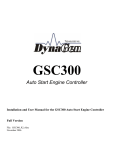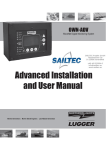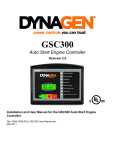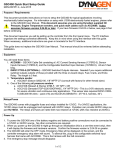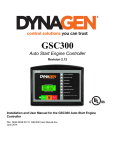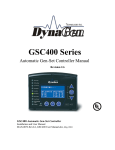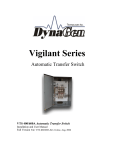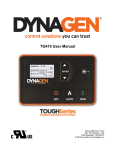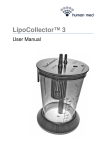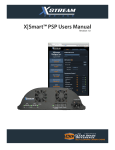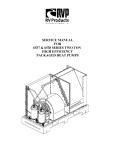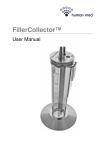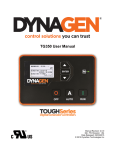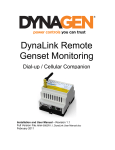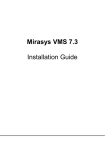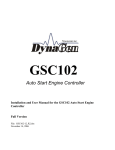Download GSC400 Series
Transcript
GSC400 Series Automatic Engine Controller GSC400 Automatic Engine Controller Installation and User Manual Full Version File: GSC400 Rev1.2.doc, April 2006 2 Thank You For Purchasing This DynaGen Product Please Read Manual Before Installing Unit Receipt of Shipment and Warranty Return Information Upon receipt of shipment, carefully remove the unit from the shipping container and thoroughly examine the unit for shipping damage. In case of damage, immediately contact the carrier and request that an inspection report be filed prior to contacting DynaGen. All returned items are to be shipped prepaid and include a Return Material Authorization (RMA) number issued by DynaGen. RMA forms are available by contacting DynaGen Technical Support through the contact methods listed below. Limited Warranty DynaGen will repair or replace any GSC400 series engine controller which proves to be defective under normal and proper use within Three Years from the date of shipment. This constitutes the only warranty and no other warranty shall be implied. We welcome your comments and suggestions. Please contact us at: DynaGen Technologies Inc. Phone: 1-888-396-2436 (902) 562 0133 Fax: (902) 567 0633 Email: [email protected] WEB SITE: www.dynagen.ca User Manual for the GSC400 Series Automatic Engine Controller 3 Table of Contents GSC400 Series Specifications 4 1.0 GSC400 Product Series 5 2.0 Receiving, Handling, and Storage 2.1 Receiving: 2.2 Handling 2.3 Storage 6 3.0 GSC400 Product Number Identification 7 4.0 GSC400 Series Installation and Wiring 4.1 General information 4.2 Mounting location 4.3 Connector Layout 4.4 Connector Information 4.5 AC Voltage Sensing 4.6 AC Current Sensing 4.7 AC Wiring Diagram 4.8 DC Wiring Diagram 4.9 Analog Input Wiring Diagram 4.10 Digital Input wiring Diagram 4.11 Connector Details 8 5.0 GSC400 Modes of Operation 5.1 Off mode 5.2 Auto mode 5.3 Start mode 22 6.0 GSC400 Menu System 6.1 GSC400 menu overview 6.2 Clock setup 6.3 Basic setup 6.4 Advanced setup 6.5 Failure history 6.6 DefaultGSC400 Settings 23 7:0 LED Status Indicators 7.1 LED indicator chart 51 8.0 GSC400 Recommended Maintenance 54 User Manual for the GSC400 Series Automatic Engine Controller 4 GSC400 Specifications VDC Rating DC Power Cons. Operating Temp Function Selection Range Function Speed Sensing Voltage Sensing Current Sensing* Frequency Sensing Engine Temp 12/24 VDC 25 mA @ 12 VDC -40°C to +85°C (-40°F to +185°F) Selection Range Generator pickup 0-300vac, 0-3600rpm Magnetic pickup 0-300vac, 0-3600rpm Single phase, Max 700vac, +/- 1% Three phase, Max 700vac, +/- 1% Delta, Wye Max 700vac, +/- 1% Enable/Disable Max 5A, +/- 1% Enable/Disable 1 – 100 HZ GND=Fail, Open=Fail 10-265°F, 10-265°C Oil Pressure Oil Level Fuel Level Engine Logic LCD Display LED Display Programming J1939 Interface Relays** Dimensions Weight GND=Fail, Open=Fail 0-90 PSI, 0-90 Kpa GND=Fail, Open=Fail 0-90% GND=Fail, Open=Fail 0-100% Delay to start 0 – 60 seconds Pre-heat 0 – 60 seconds Crank 3 – 60 seconds Rest Time 1 – 60 seconds Mid Heat 0 – 60 seconds Crank attempts 1-60 tries Enable, Disabled False restart Post heat 0 – 60 seconds 0 – 600 seconds Warm-up 0-600 seconds Cooldown 0-90 KPa Crank oil pressure 100-2000 RPM Crank Disconnect Analog Input Input 2, 5-7 (High Z) Gnd=Fail, Open=fail Input 3-4 (Low Z) 7mA Max Digital Input Input A-D (Sw to Bat) Bat=Fail, 7mA Max Input E-H (Sw to Gnd) Gnd=Fail, 7mA Max Digital Output Output A-H 300 mA Max Extra Relay 40A Max Exerciser Enable, Disable 10-240 Minutes Battery Recharge Enable, Disable 10-240 Minutes Password 4-Digit 0-9 128x64 Graphic display, Backlit, 60° viewing angle, LCD operating temperature -30°C to +60°C (-22°F to +140°F) Red, Green, Yellow LED representation, Daytime Visible, 60° viewing angle Manual, Software, Field upgradeable Low emission capable Replaceable 40A relays for Crank, Fuel, Extra output. 12 or 24VDC Coil W x H x D , 139 x 113 x 65 mm (5.47 x 4.45 x 2.56 in.) 0.45 Kg (1.0 Lb) *Use of Industry Standard CT Required. ** 40A output at room temperature. User Manual for the GSC400 Series Automatic Engine Controller 5 1:0 GSC400 Controller Series: The GSC400 automatic engine controller is specifically designed for advanced monitoring of power generation systems. The GSC400 monitors engine logic features as well as engine characteristics. GSC400 Front View The GSC400 automatic engine controller’s advanced circuitry is specifically designed to monitor engine logic. Engine logic consisting of the start and safe shutdown of the engine are included in the GSC400 and is user adjustable allowing preference settings of options and timing. The engine controller will control the starting of the engine, delays, cranking, false restarts etc. Engine shutdowns are monitored allowing delays and cool down periods. The GSC400’s engine logic features will allow engine protection in the event of abnormal starting /stopping sequences. The GSC400 will continuously and effectually monitor engine characteristics. Engine characteristics such as temperature, pressure, RPM, voltage, current and coolant levels are closely monitored to protect the engine from any malfunctions. The GSC400 can be user adjustable to sound an audio alert to warn when a malfunction is in progress before actually shutting down the engine. The GSC400 will automatically shutdown the engine, depending upon the user settings, before any damage is afflicted to the engine. GSC400 Back View All GSC400 automatic engine controllers incorporate an LCD display and LED indications. The LCD is used for multi-tasks including displaying dates, time, menu settings, status readouts etc. User Manual for the GSC400 Series Automatic Engine Controller 6 2:0 Receiving, Handling, and Storage Receiving: Every effort is made to ensure that your GSC400 engine controller arrives at its destination undamaged and ready for installation. The packing is designed to protect the GSC400 internal components as well as the enclosure. Care should be taken to protect the equipment from impact at all times. Do not remove the protective packaging until the equipment is at the installation site and ready to be installed. When the GSC400 reaches its destination, the customer should inspect the shipping box and controller for any signs of damage that occurred during transportation. Any damage should be reported to a DynaGen representative once a through inspection is complete. A shipping label affixed to the shipping box includes a variety of product and shipping information, such as items and Customer numbers. Make certain that this information matches your order information. Each GSC400 controller is packaged in its own box. Do not discard the packing material until the controller is ready for installation. Important documents will be found inside the GSC400 controller protective packaging box including the GSC400 user and installation manual and system wiring diagrams. Handling: As previously mentioned, each GSC400 engine controller is packaged in its own individual box. Protect the equipment from impact at all times and do not carelessly stack. Once the controller is at the installation site and ready to be installed, the packaging material may be removed. Storage: Although well packaged, this equipment is not suitable for outdoor storage. If the GSC400 is to be stored indoors for any period of time, it should be stored with its protective packaging in place. Protect the controller at all times from excessive moisture, dirty conditions, corrosive conditions, and other contaminants. It is strongly recommended that the package-protected equipment be stored in a climate-controlled environment of -20 to 65°C (-4 to 149°F), with a relative humidity of 80% or less. Do not stack other equipment on top of the stored controllers. User Manual for the GSC400 Series Automatic Engine Controller 7 3.0 GSC400 Product Number Identification: The GSC400 series product numbering scheme provides significant information pertaining to a specific model. The product Number Identification Table (see Table 1) provides the required interpretation information. An example is offered to initially simplify the process. A product number GSC400-X-XX-XX would consist of a combination of information from the following table. TABLE1: IDENTIFICATION TABLE Position 1-6 Position 8 Position 10-11 Position 13-14 Series Place Value DC Voltage Labeling GSC400=GSC400 No Meaning 12=12VDC 24=24VDC LS=Standard LX=Customized Example: The product number GSC400-0-12-LS would be described as follows: A GSC400 series automatic engine controller configured for a 12 VDC system, which includes standard labeling. A GSC400 serial number would be displayed as: GSC400-0-12-LS-00000 User Manual for the GSC400 Series Automatic Engine Controller 8 4:0 GSC400 Series Installation and Wiring: The GSC400 may carry high Voltage/Current which can cause serious injury or death. Extreme caution must be exercised when connections are being installed to or from the controller. All wiring connections must be de-energized before any installations are performed. Wiring of the GSC400 should be performed by qualified electricians only. 4:1 General Information: All GSC400 engine controllers are factory tested and approved. Customer installation requires the mounting of the controller as well as all external wiring for normal operation. Once the GSC400 engine controller is properly installed, it should be visually inspected and approved before any testing is performed. 4:2 Mounting Location: Figure 1 – GSC400 Mounting Locations The GSC400 engine controller must be properly mounted for safe operation. Caution must be taken at the installation site to make sure the site is free from excessive moisture, fluctuating temperature ranges, dust, corrosive materials etc. The controller should be safely mounted in a secure location using the 3 mounting screws provided. See mounting location in figure 1. Caution: Mounting screws must be installed at the recommended torque of 10 inch pounds. User Manual for the GSC400 Series Automatic Engine Controller 9 4:2.1 GSC400 Mounting Dimensions: User Manual for the GSC400 Series Automatic Engine Controller 10 4:3 GSC400 Typical Connector Layout: Electrical Installation Note Many electrical connections need to be installed to the GSC400 for proper operation. Wire harnesses and/or wire harness plug connectors may be supplied to the customer upon request. Wire harnesses/connectors would include: • • • • • Two (2) – 6-position connectors (2x3) for AC current sensing and RS485 Input. One (1) – 4-position connector (2x2) for J1939. One (1) – 8-position connector (2x4) for Analog Input. One (1) – 10-position connector (2x5) for Digital Output. One (1) – 12-position connector (2x6) for Digital Input. Additionally there are several 1/4" blade type quick connect terminals for the higher voltage/current connections. Quick connects would include: • • • • Two (2) – Quick connects for speed sensing. Four (4) – Quick connects for AC voltage sensing. Four (4) – Quick connects for power connection. Four (4) – Quick connects for Fuel, Crank and extra relay connection. User Manual for the GSC400 Series Automatic Engine Controller 11 4:4 GSC400 Typical Connector Information: User Manual for the GSC400 Series Automatic Engine Controller 12 4:5 GSC400 AC Voltage Connection: AC power may carry high Voltage/Current which can cause serious injury or death. De-energize all AC power sources before any connections are performed. AC electrical connections need to be applied to the GSC400 for proper AC voltage sensing. AC power is supplied to the AC Voltage Sensing blade terminals located on the GSC400. Connections would be installed as follows: In single phase applications • Phase A to terminal Phase A • Phase B to terminal Phase B • Neutral to terminal Neutral In three phase applications • Phase A to terminal Phase A • Phase B to terminal Phase B • Phase C to terminal Phase C • Neutral to terminal Neutral In center tapped delta applications • Phase A to terminal Phase A • Phase B to terminal Phase B • Phase C to terminal Phase C • Neutral to terminal Neutral User Manual for the GSC400 Series Automatic Engine Controller 13 4:6 GSC400 AC Current Sensing: AC power may carry high Voltage/Current which can cause serious injury or death. De-energize all AC power sources before any connections are performed. Current transformers need to be applied to the electrical wiring between the power source and load connections for current sensing. Current transformers are supplied to the AC Current Sensing connector located on the GSC400. Connections would be installed as follows: In single phase applications • Phase A to terminals Phase A* In three phase applications • Phase A to terminals Phase A* • Phase B to terminals Phase B* • Phase C to terminals Phase C* In center tapped delta applications • Phase A to terminals Phase A* • Phase B to terminals Phase B* • Phase C to terminals Phase C* *White wire assumed positive *Black wire assumed negative NEVER energize AC power with AC current sensing connector unplugged form GSC400. An energized unplugged connector could result in severe injury or death. Never unplug energized connector. User Manual for the GSC400 Series Automatic Engine Controller 14 4:7 GSC400 AC Wiring Diagram: 4:8 GSC400 DC Wiring Diagram: User Manual for the GSC400 Series Automatic Engine Controller 15 4:9 GSC400 Analog Input Wiring Diagram: 4:10 GSC400 Digital Input Wiring Diagram: User Manual for the GSC400 Series Automatic Engine Controller 16 GSC400 12/24VDC SYSTEM OPERATION The GSC400 controller is designed to operate in either 12 or 24 VDC system voltages. When operating in 12VDC systems the fuel, crank and extra relays need to be the proper 12VDC relay type. When operating in 24VDC systems these relays need to be the proper 24VDC relay type. Contact the factory if relays are required. Approved relays for 12 or 24VDC system operation are as follows: • • AZETTLER – AZ973-1C-12DC for 12VDC operation AZETTLER – AZ973-1C-24DC for 24VDC operation User Manual for the GSC400 Series Automatic Engine Controller 17 GSC400 Fuse Protected 40A Relay Output CAUTION needs to be taken when connecting relay outputs to an inductive load. Due to the inductive nature of certain loads (starters, pull coils) initial current draw may be higher then stated in load specs causing damage to onboard relays. Output relays are protected by onboard 40A fuse protection. Smaller amperage fuses from many automotive stores may be used in place of the higher current 40A. If installing lower amperage fuse protection be certain that current draw does not exceed the fuse current limit. An approved 40A fuse is as follows: • LITTLEFUSE – 257040 (32VDC, 40A, Auto fast Action) User Manual for the GSC400 Series Automatic Engine Controller 18 GSC400 Connector Details GSC400 Quick Fit Terminal The GSC400 quick Fit terminals are used for high power connections. Controller relay outputs are also connected to the quick fit terminal section. Terminal Crank Battery + Battery Fuel Extra Relay Speed 1 Speed 2 Wire Size (AWG) 12 12 12 12 12 18 18 *Current max. 40A 40A 40A 40A 40A 100mA 100mA Function Crank Output Terminal Positive Battery Terminal Negative Battery Terminal Fuel Output Terminal Extra Relay Output Terminal Speed Signal Connection Speed Signal Connection *Total controller current output (max 60A) User Manual for the GSC400 Series Automatic Engine Controller 19 GSC400 Analog Input Connection The GSC400 analog input connector is used to connect analog input devices to the controller such as switches or senders. Single wire switch/senders may be connected to the proper input terminal with grounding supplied at the sender itself. Two wire switch/senders must be grounded to the ground terminal on the connecter. If more then two 2-wire switch/senders are used, sender grounds must be tied together at the ground terminal on the connecter. Terminal Detail Ground Input 2 - High Input 3 - Low Input 4 - Low Input 5 - High Input 6- High Input 7- High Ground Terminal Location 1 2 3 4 5 6 7 8 Wire Size (AWG) 18 18 18 18 18 18 18 18 Current max. 7mA 7mA 7mA 7mA 7mA 7mA 7mA 7mA Function Ground Terminal Connection Configurable¹ Configurable² Configurable² Configurable¹ Configurable¹ Configurable¹ Ground ¹Senders requiring high pull-up use input 2, 5, 6, 7 which use high impedance pull-up ²Senders requiring low pull-up use input 3, 4 which use low impedance pull-up GSC400 Digital Input Connection The GSC400 digital input connector is used to connect digital input devices to the controller such as senders. Single wire senders may be connected to the proper input terminal with grounding supplied at the sender itself. Two wire senders must be grounded to the ground terminal on the connecter. If more then two 2-wire senders are used, sender grounds must be tied together at the ground terminal on the connecter. Start/Stop and Emergency stop are energized to ground only. Terminal Detail Input H - GND Input G - GND Input F - GND Input E - GND Input D - BAT Input C - BAT Input B - BAT Input A - BAT Emer. Stop Start/Stop Dry Con (S/S) Ground Terminal Location 1 2 3 4 5 6 7 8 9 10 11 12 Wire Size (AWG) 18 18 18 18 18 18 18 18 18 18 18 18 Current max. 7mA 7mA 7mA 7mA 7mA 7mA 7mA 7mA 7mA 7mA 7mA 7mA Function Configurable* Configurable* Configurable* Configurable* Configurable* Configurable* Configurable* Configurable* Allows Manual Emergency Stop Allows Manual Start/Stop of Engine Dry Contacts of Start/Stop Relay Ground Terminal Connector *See Advanced Setup Menu Chart under Digital Input Setup for possible selections Input A-D (switch to Bat) +Bat = fail, Input E-H (switch to Gnd) Gnd = fail User Manual for the GSC400 Series Automatic Engine Controller 20 GSC400 RS485 Input Connection The GSC400 RS485 input connector is used for serial data communications. This connector may be used for software programming of the GSC400 using the GSC400 configurator software. Terminal Detail RS485-A Ground RS485-B RS485-A Ground RS485-B Terminal Location 1 2 3 4 5 6 Wire Size (AWG) 18 18 18 18 18 18 Current max. 7mA 7mA 7mA 7mA 7mA 7mA Function RS485 Connection Ground Terminal Connection RS485 Connection RS485 Connection Ground Terminal Connection RS485 Connection GSC400 Digital Output Connection The GSC400 digital output connector is used to connect up to 8 outputs. Each output can be assigned 1 of the 34 possible selections. Sinking Outputs. Terminal Detail + Bat Output A Output B Output C Output D Output E Output F Output G Output H + Bat Terminal Location 1 2 3 4 5 6 7 8 9 10 Wire Size (AWG) 18 18 18 18 18 18 18 18 18 18 Current max. 1.5A 200mA 200mA 200mA 200mA 200mA 200mA 200mA 200mA 1.5A Function Positive Battery Voltage Configurable* Configurable* Configurable* Configurable* Configurable* Configurable* Configurable* Configurable* Positive Battery Voltage *See Advanced Setup Menu Chart under Digital Output Setup for possible selections GSC400 AC Voltage Sensing Connection The GSC400 AC Voltage Sensing connector is used to measure the level of AC voltage being supplied to the system. Terminal Phase A Phase B Phase C Neutral Wire Size (AWG) 18 18 18 18 Current max. 7mA 7mA 7mA 7mA Function Monitor Generated AC Voltage Monitor Generated AC Voltage Monitor Generated AC Voltage AC Voltage Neutral connection User Manual for the GSC400 Series Automatic Engine Controller 21 GSC400 AC Current Sensing Connection The GSC400 AC Current Sensing connector is used to measure the level of AC current being drawn from the load. It is extremely important to connect each phase to the appropriate terminal location. Never mix phase inputs. Always match terminal details to the matching terminal location. Terminal Detail Phase A Phase B Phase C Phase A Phase B Phase C Terminal Location 1 2 3 4 5 6 Wire Size (AWG) 18 18 18 18 18 18 Current max. 5A 5A 5A 5A 5A 5A Function Phase A current sensing CTPhase B current sensing CTPhase C current sensing CTPhase A current sensing CT+ Phase B current sensing CT+ Phase C current sensing CT+ GSC400 J1939 Canbus Connection The GSC400 J1939 Canbus connector is used to communicate between J1939 complaint engines. Terminal Detail CANH Ground CANL Ground Terminal Location 1 2 3 4 Wire Size (AWG) 18 18 18 18 Current max. 7mA 7mA 7mA 7mA Function CANH Connection Ground Terminal Connection CANL Connection Ground Terminal Connection User Manual for the GSC400 Series Automatic Engine Controller 22 5:0 GSC400 Operation Modes: The GSC400 incorporates 3 modes of operation: 1. OFF Mode 2. AUTO Mode 3. Manual Run Mode 1. OFF Mode – When the GSC400 is set to the Off Mode, starting will be disabled. No automatic controls will be initiated. The Off Mode may be initiated when no engine controls are required or when the menu system requires adjustment. 2. AUTO Mode - When the GSC400 is set to the Auto Mode, automatic starting will be enabled. Auto Mode allows for the automatic control of the engine. Possible causes of starting include start/stop, battery recharge and exerciser features. Failures will be automatically detected allowing for safe engine operation. 3. Manual Run Mode - When the GSC400 is set to the manual run Mode, starting will be enabled. Start Mode allows for immediate manual engine starting and operation. When in Start Mode, the engine will run until the OFF Mode is chosen or a failure is recognized. Controller must be in auto mode to initiate Manual run. User Manual for the GSC400 Series Automatic Engine Controller 23 6:0 GSC400 Menu System: The GSC400 utilizes an advanced yet user friendly menu system. The menu system can be initiated to perform adjustments within the GSC400. Adjustments can range from simple basic selections including time settings to more advanced selections including engine logic, input selection, output selection etc. Although the GSC400 is shipped factory configured either to its default or customer requested ranges, the internal menu system can be easily initiated for adjustments. With the controller in the off mode, the menu system may be selected simply by pressing the enter button. Press “OFF” followed by “ENTER” to initiate GSC400 Menu System. Scroll using the and buttons on the GSC400. Enter selections by depressing the enter button 1 2 The backlight display will illuminate automatically upon button activation. The backlight will stay on for a period of 60 seconds. User Manual for the GSC400 Series Automatic Engine Controller 24 6:1 GSC400 Controller Menu Overview: The GSC400 Controller Features the Following Menu Functions: 1. 2. 3. 4. Clock Setup Basic Setup Advanced Setup Failure History 6:2 CLOCK SETUP: FUNCTION Back Year Month Date Day Hour Minute 12/24 1. Year: SELECTION AND RANGE Used to go back to previous menu 2000 - 2099 01-Jan to 12-Dec 01-31 Monday - Sunday 00-23 00-59 12/24 hour time display User selectable allowing current year LCD display. 2. Month: User selectable allowing current month LCD display. 3. Date: User selectable allowing current date LCD display. 4. Day: User selectable allowing current day LCD display. 5. Hour: User selectable allowing current hour LCD display. Hour must always be set in 24 hour time regardless of the 12/24 display setting. 6. Minute: User selectable allowing current minute LCD display. 7. 12/24: User selectable allowing current time LCD display. Time may be displayed in 12/24 hour status. User Manual for the GSC400 Series Automatic Engine Controller 25 6:3 BASIC SETUP: FUNCTION Contrast Adjust Page Roll Delay State Roll Delay SELECTION AND RANGE 5-95 % 1-10 s 1-10 s 1. Contrast Adjust: User selectable allowing different percent LCD contrast ratios. 2. Page Roll Delay: User selectable allowing page roll delay times during run mode. 3. State Roll Delay: User selectable allowing state roll delay times during run mode. The contrast and delay settings will be automatically temperature compensated below 0º C. The compensated settings will allow the LCD display to be better viewable at lower temperatures. Please note that this is an automatic compensation and does not effect the actual contract adjust setting. If the controller is set for a 50% brightness level the display will stay at the level through a temperature change. User Manual for the GSC400 Series Automatic Engine Controller 26 6:4 ADVANCED SETUP: The GSC400 incorporates an advanced setup menu function. Advanced setup features include input, output and other advanced settings which are adjustable by the user if required. See the possible advanced setup menu selections on the following page. A password is required to be correctly entered allowing access to the advanced menu selections. The password will consist of a four digit number. Each number needs to be selected using the up or down arrows on the GSC400. Simply choose the correct password number for each selected position by scrolling to the proper number followed by the enter button. The default company password will be 0 0 0 0. The password may be changed anytime. See Password Setup section. The Advanced Setup menu on the GSC400. User Manual for the GSC400 Series Automatic Engine Controller 27 Advanced Setup Menu FUNCTION J1939 Setup High Engine Temp Oil Pressure Fuel Level SELECTION AND RANGE Manufacturer Display Group 1 Display Group 2 Input Pin Signal Source Bypass Delay Switch Setting Shorted Sender Open Sender Units Warning Level Failure Level Input Pin Signal Source Bypass Delay Switch Setting Shorted Sender Open Sender Units Warning Level Failure Level Input Pin Signal Source Bypass Delay Switch Setting Shorted Sender Open Sender Units Warning Level Failure Level Select J1939 ECU manufacturer Enable, Disable Enable, Disable Reserve, Analog 2-7 J1939, Switch input, Sender 0-60 Seconds GND = Fail, Open = Fail Disable, Warning, Shutdown Disable, Warning, Shutdown Fahrenheit, Celius 10-265°F, 10-265°C 10-265°F, 10-265°C Reserve, Analog 2-7 J1939, Switch input, Sender 0-60 Seconds GND = Fail, Open = Fail Disable, Warning, Shutdown Disable, Warning, Shutdown PSI, KPa 0-90 PSI, 0-90 KPa 0-90 PSI, 0-90 KPa Reserve, Analog 2-7 J1939, Switch input, Sender 0-60 Seconds GND = Fail, Open = Fail Disable, Warning, Shutdown Disable, Warning, Shutdown Percentage 0-90% 0-90% User Manual for the GSC400 Series Automatic Engine Controller 28 Fuel Level (continued) Oil Level Fuel In Basin Low Engine Temperature Spd Sensing AC Frequency A/C Voltage 0% Fuel Level 25% Fuel Level 50% Fuel Level 75% Fuel Level 100% Fuel Level Input Pin Signal Source Bypass Delay Switch Setting Shorted Sender Open Sender Units Warning Level Failure Level Input Pin Signal Source Bypass Delay Switch Setting Shorted Sender Open Sender Units Warning Level Failure Level Input Pin Signal Source Bypass Delay Switch Setting Shorted Sender Open Sender Units Warning Level Failure Level 0-1000 Ohms (data sheet or measured value) 0-1000 Ohms (data sheet or measured value) 0-1000 Ohms (data sheet or measured value) 0-1000 Ohms (data sheet or measured value) 0-1000 Ohms (data sheet or measured value) Reserve, Analog 2-7 J1939, Switch input, Sender 0-60 Seconds GND = Fail, Open = Fail Disable, Warning, Shutdown Disable, Warning, Shutdown Percentage 0-100% 0-100% Reserve, Analog 2-7 J1939, Switch input, Sender 10-60 Seconds GND = Fail, Open = Fail Disable, Warning, Shutdown Disable, Warning, Shutdown Percentage 0-90% 0-90% Reserve, Analog 2-7 J1939, Switch input, Sender 10-60 Seconds GND = Fail, Open = Fail Disable, Warning, Shutdown Disable, Warning, Shutdown Fahrenheit, Celius 10-265°F, 10-265°C 10-265°F, 10-265°C Signal Source Rated Freq Rated RPM Over Speed Warn Over Speed Fail Under Speed Warn Under Speed Fail Frequency Disconnect Over Freq Warn Over Freq Fail Under Freq Warn Under Freq Fail Voltage Source Voltage Display Voltage Group Over Volt Warn 1 Over Volt Fail 1 Under Volt Warn 1 Under Volt Fail 1 Over Volt Warn 2 Over Volt Fail 2 J1939, Mag pickup, Gen output 10-9990 Hz 200-4000 RPM 100-5000 RPM 100-5000 RPM 100-5000 RPM 100-5000 RPM 1-100 Hz 1-100 Hz 1-100 Hz 1-100 Hz 1-100 Hz Disable, Wye Line-Line, Line-Neutral 1-Single, 2-Three, 3-Hi Wye, 4-Three phase 0-700 VAC 0-700 VAC 0-700 VAC 0-700 VAC 0-700 VAC 0-700 VAC User Manual for the GSC400 Series Automatic Engine Controller 29 A/C Voltage (continued) A/C Current Engine Logic Digital Output Setup All selections apply to each individual output A specific selection may be mapped to more then one output to allow for higher current output. Under Volt Warn 2 Under Volt Fail 2 Over Volt Warn 3 Over Volt Fail 3 Under Volt Warn 3 Under Volt Fail 3 Over Volt Warn 4 Over Volt Fail 4 Under Volt Warn 4 Under Volt Fail 4 Current source Turns Ratio Over Current Warn 1 Over Current Fail 1 Over Current Warn 2 Over Current Fail 2 Over Current Warn 3 Over Current Fail 3 Over Current Warn 4 Over Current Fail 4 0-700 VAC 0-700 VAC 0-700 VAC 0-700 VAC 0-700 VAC 0-700 VAC 0-700 VAC 0-700 VAC 0-700 VAC 0-700 VAC Disable, Enable 5-5000A:5A 0-6500 A 0-6500 A 0-6500 A 0-6500 A 0-6500 A 0-6500 A 0-6500 A 0-6500 A Delay to Start Pre-heat Time Crank Time MidHeat Time Crank Rest Time Crank Attempts Fuel Crank Rest False Restart Post-Heat Time ETS On Duration Warm-up Time Crank Disconnect Cool Down Delay Crank Oil pres 0-60 seconds 0-60 seconds 3-60 seconds 0-60 seconds 1-60 seconds 1-60 Disable, Enable Disable, Enable 0-60 seconds 0-30 seconds 0-600 seconds 100-2000 RPM 0-600 seconds 0-90 Psi Extra Relay Output A Output B Output C Output D Output E Output F Output G Output H Disable, Warm-Up, ETS, Pre-heat, Cooldown, Over Crank , High Temp Fail , High Temp warn, Low Oil Fail , Low Oil warn, Under Speed Fail, Under Speed Warn, Over Speed Fail Over Speed Warn, Low Fuel Fail Low Fuel Warn, Battery Fail, Battery Warn, Low Coolant Fail, Low Coolant warn, Not in Auto, Failure, Crank Rest, Engine Running, Crank On, Exerciser Alarm, Recharge Alarm Under Volt Warn, Over volt warn, Over Amp Warn, Fuel in Basin, Volt Regulator, Low Temp Warn. Back Light, Aux Warn. User Manual for the GSC400 Series Automatic Engine Controller 30 Exerciser Enable Run Duration Pre-Alarm Delay Repeat Frequency Start Hour Start Date Input A (Bat) Input B (Bat) Input C (Bat) Input D (Bat) Input E (Gnd) Input F (Gnd) Input G (Gnd) Input H (Gnd) Low Auto Charge Charge Pre-Alarm Charge Duration Recharge Level Low Warn Level Low Fail Level High Warn Level High Fail Level Password No. 1 Password No. 2 Password No. 3 Password No. 4 Exerciser setup Digital Input Setup All selections apply to each individual input Battery Setup Set Password Disable, enable 10-240 minutes 1-20 minutes 1-672 hours 0-23 1-31 Disable, Low Air Pressure Low Hydraulic Pressure, EPS Supply Load Alarm Silence, Low Coolant, Volt Select 1, Volt Select 2, Idle Mode, Start/Stop Auxilary Warn/Failure Disable, enable 1-60 minutes 10-240 minutes 7-24 volts 7-24 volts 7-24 volts 12-32 volts 12-32 volts 0-9 0-9 0-9 0-9 6.4.1 J1939 Setup: a.) Manufacturer: Select engine manufacturer from list (John Deere/Volvo). b.) Display Group1: Enable/Disable extra display parameters displayed while running. c.) Display Group2: Enable/Disable extra display parameters displayed while running. Engine Manufacturer John Deere Volvo Penta Display Group 1 Percent Engine Torque, Percent Friction Torque, Percent Load Percent Engine Torque, Percent Friction Torque, Percent Load User Manual for the GSC400 Series Automatic Engine Controller Display Group 2 Intake Temperature, Fuel Temperature, Fuel Rate Boost Pressure, Oil Temperature, Fuel Rate 31 6.4.2 High Engine Temp: This function allows the user to select the following settings: a.) Input Pin: Input 2-7 may be configured to High Engine Temp. A specific input can be assigned only once to any given function at any one time. If using a sender be careful to select a Low or High impedance input location to correspond to the sender specifications. Reserve may be selected to configure proper setting without assigning an active input. b.) Signal Source: How to obtain a high engine temperature failure. The J1939 interface may be selected for a J1939 compliant engine. The switch input may be selected for a mechanical switch gauge types. Senders may be selected for electronic gauge types. c.) Bypass Delay: When to recognize an engine temperature failure. Bypass delay is the time in seconds the GSC400 will wait after crank success before checking engine for high engine temperature. d.) Switch Setting: When the Switch Input is selected as the signal source, the switch setting can be configured for a ground or open failure. Gnd means that ground would be a failure, +BAT would be “Engine OK”. Open means that open switch contacts would be “Failure”, and closed switch contacts would be a “Engine OK”. e.) Shorted Sender: When the Sender Input is selected as the signal source, a shorted sender can display a warning, shutdown the engine or be set to have no effect (disable). f.) Open Sender: When the Sender Input is selected as the signal source, an open sender can display a warning, shutdown the engine or be set to have no effect (disable). g.) Units: Fahrenheit or Celsius selectable. h.) Warning Level: Using an electronic sender or J1939 input, a value of 10-265° may be selected to initiating a warning. Please note that if warning level is set to a greater value then failure level, no warning will be generated. i.) Failure Level: Using an electronic sender or J1939 input, a value of 10-265° may be selected to initiating a Failure. User Manual for the GSC400 Series Automatic Engine Controller 32 6.4.3 Oil Pressure: This function allows the user to select the following settings: a.) Input Pin: Input 2-7 may be configured to Oil Pressure. A specific input can be assigned only once to any given function at any one time. If using a sender be careful to select a Low or High impedance input location to correspond to the sender specifications. Reserve may be selected to configure proper setting without assigning an active input. b.) Signal Source: How to obtain an oil pressure failure. The J1939 interface may be selected for a J1939 compliant engine. The switch input may be selected for a mechanical switch gauge types. Senders may be selected for electronic gauge types. c.) Bypass Delay: When to recognize an oil pressure failure. Bypass delay is the time in seconds the GSC400 will wait after crank success before checking engine Pressure. d.) Switch Setting: When the Switch Input is selected as the signal source, the switch setting can be configured for a ground or open failure. Gnd means that ground would be a failure, +BAT would be “Engine OK”. Open means that open switch contacts would be “Failure”, and closed switch contacts would be a “Engine OK” e.) Shorted Sender: When the Sender Input is selected as the signal source, a shorted sender can display a warning, shutdown the engine or be set to have no effect (disable). f.) Open Sender: When the Sender Input is selected as the signal source, an open sender can display a warning, shutdown the engine or be set to have no effect (disable). g.) Units: PSI or Kpa selectable. h.) Warning Level: Using an electronic sender or J1939 input, a value of 0-90 may be selected to initiating a warning. Please note that if warning level is set to a greater value then failure level, no warning will be generated. i.) Failure Level: Using an electronic sender or J1939 input, a value of 0-90 may be selected to initiating a Failure. User Manual for the GSC400 Series Automatic Engine Controller 33 6.4.4 Fuel Level: This function allows the user to select the following settings: a.) Input Pin: Input 2-7 may be configured to Fuel Level. An input can only be assigned to any given function once at any given time. If using a sender be careful to select a Low or High impedance input location to correspond to the sender specifications. Reserve may be selected to configure proper setting without assigning an active input. b.) Signal Source: How to obtain an engine temperature failure. The J1939 interface may be selected for a J1939 compliant engine. The switch input may be selected for a mechanical switch gauge types. Senders may be selected for electronic gauge types. Sender values for 0%, 25%, 50%, 75% and 100% are entered. c.) Bypass Delay: When to recognize a fuel level failure. Bypass delay is the time in seconds the GSC400 will wait after crank success before checking fuel level. d.) Switch Setting: When the Switch Input is selected as the signal source, the switch setting can be configured for a ground or open failure. Gnd means that ground would be a failure, +BAT would be “Engine OK”. Open means that open switch contacts would be “Failure”, and closed switch contacts would be a “Engine OK” e.) Shorted Sender: When the Sender Input is selected as the signal source, a shorted sender can display a warning, shutdown the engine or be set to have no effect (disable). f.) Open Sender: When the Sender Input is selected as the signal source, an open sender can display a warning, shutdown the engine or be set to have no effect (disable). g.) Units: Percentage. h.) Warning Level: Using an electronic sender or J1939 input, a value of 0-90% may be selected to initiating a warning. Please note that if warning level is set to a greater value then failure level, no warning will be generated. i.) Failure Level: Using an electronic sender or J1939 input, a value of 0-90% may be selected to initiating a Failure. User Manual for the GSC400 Series Automatic Engine Controller 34 6.4.5 Oil Level: This function allows the user to select the following settings: a.) Input Pin: Input 2-7 may be configured to Oil level. An input can only be assigned to any given function once at any given time. If using a sender be careful to select a Low or High impedance input location to correspond to the sender specifications. Reserve may be selected to configure proper setting without assigning an active input. b.) Signal Source: How to obtain an oil level failure. The J1939 interface may be selected for a J1939 compliant engine. The switch input may be selected for a mechanical switch gauge types. Senders may be selected for electronic gauge types. c.) Bypass Delay: When to recognize an oil level failure. Bypass delay is the time in seconds the GSC400 will wait after crank success before checking oil level. d.) Switch Setting: When the Switch Input is selected as the signal source, the switch setting can be configured for a ground or open failure. Gnd means that ground would be a failure, +BAT would be “Engine OK”. Open means that open switch contacts would be “Failure”, and closed switch contacts would be a “Engine OK” e.) Shorted Sender: When the Sender Input is selected as the signal source, a shorted sender can display a warning, shutdown the engine or be set to have no effect (disable). f.) Open Sender: When the Sender Input is selected as the signal source, an open sender can display a warning, shutdown the engine or be set to have no effect (disable). g.) Units: Percentage. h.) Warning Level: Using an electronic sender, a value of 0-100% may be selected to initiating a warning. Please note that if warning level is set to a greater value then failure level, no warning will be generated. i.) Failure Level: Using an electronic sender, a value of 0-100% may be selected to initiating a Failure. User Manual for the GSC400 Series Automatic Engine Controller 35 6.4.6 Fuel in Basin: This function allows the user to select the following settings: a.) Input Pin: Input 2-7 may be configured to Fuel in Basin. An input can only be assigned to any given function once at any given time. If using a sender be careful to select a Low or High input impedance location to correspond to the sender specifications. Reserve may be selected to configure proper setting without assigning an active input. b.) Signal Source: How to obtain a fuel in basin failure. The J1939 interface may be selected for a J1939 compliant engine. The switch input may be selected for a mechanical switch gauge types. Senders may be selected for electronic gauge types. c.) Bypass Delay: When to recognize a fuel in basin failure. Bypass delay is the time in seconds the GSC400 will wait after crank success before checking for a fuel in basin failure. d.) Switch Setting: When the Switch Input is selected as the signal source, the switch setting can be configured for a ground or open failure. Gnd means that ground would be a failure, +BAT would be “Engine OK”. Open means that open switch contacts would be “Failure”, and closed switch contacts would be a “Engine OK” e.) Shorted Sender: When the Sender Input is selected as the signal source, a shorted sender can display a warning, shutdown the engine or be set to have no effect (disable). f.) Open Sender: When the Sender Input is selected as the signal source, an open sender can display a warning, shutdown the engine or be set to have no effect (disable). g.) Warning Level: Using an electronic sender, a value of 0-90% may be selected to initiating a warning. Please note that if warning level is set to a greater value then failure level, no warning will be generated. h.) Failure Level: Using an electronic sender, a value of 0-90% may be selected to initiating a Failure. User Manual for the GSC400 Series Automatic Engine Controller 36 6.4.7 Low Engine Temp: This function allows the user to select the following settings: a.) Input Pin: Input 2-7 may be configured to Low Engine Temp. An input can only be assigned to any given function once at any given time. If using a sender be careful to select a Low or High impedance input location to correspond to the sender specifications. Reserve may be selected to configure proper setting without assigning an active input. b.) Signal Source: How to obtain a low engine temperature failure. The J1939 interface may be selected for a J1939 compliant engine. The switch input may be selected for a mechanical switch gauge types. Senders may be selected for electronic gauge types. c.) Bypass Delay: When to recognize a low engine temperature failure. Bypass delay is the time in seconds the GSC400 will wait after crank success before checking engine temperature. d.) Switch Setting: When the Switch Input is selected as the signal source, the switch setting can be configured for a ground or open failure. Gnd means that ground would be a failure, +BAT would be “Engine OK”. Open means that open switch contacts would be “Failure”, and closed switch contacts would be a “Engine OK”. e.) Shorted Sender: When the Sender Input is selected as the signal source, a shorted sender can display a warning, shutdown the engine or be set to have no effect (disable). f.) Open Sender: When the Sender Input is selected as the signal source, an open sender can display a warning, shutdown the engine or be set to have no effect (disable). g.) Units: Fahrenheit or Celsius selectable. h.) Warning Level: Using an electronic sender or J1939 input, a value of 10-265° may be selected to initiating a warning. Please note that if warning level is set to a greater value then failure level, no warning will be generated. i.) Failure Level: Using an electronic sender or J1939 input, a value of 10-265° may be selected to initiating a Failure. User Manual for the GSC400 Series Automatic Engine Controller 37 6.4.5 Speed Sensing: This function allows the user to select the following settings: a.) Signal Source: How to obtain engine speed. The J1939 interface may be selected for a J1939 compliant engine. The magnetic pickup option may be selected for speed sensing from the engine flywheel. Generator output option may be selected for speed sensing directly from the generator output. b.) Rated Freq: Normal running frequency of the engine. Used to calculate engine speed. Select rated frequency between 10-9990 Hz c.) Rated Speed: Normal running speed of the engine. Used to calculate engine speed. Select rated speed between 200-4000 RPM d.) Over Speed Warning: This warning value is the value in RPM which the controller will recognize if the RPM level exceeds the setting and indicate a warning condition. A value of between 100-5000 RPM may be selected. * Please note that if warning level is set to a greater value then failure level, no warning will be generated. e.) Over Speed Failure: When the engine is running the RPM level is measured, the GSC400 can be configured for a choosing failure value. The Failure value is the value in RPM which the controller will recognize a failure. A value of between 100-5000 RPM may be selected. f.) Under Speed Warning: This warning value is the value in RPM which the controller will recognize if the RPM level goes beneath the setting and indicate a warning condition. A value of between 100-5000 RPM may be selected. * Please note that if warning level is set to a less value then failure level, no warning will be generated. g.) Under Speed Failure: When the engine is running the RPM level is measured, the GSC400 can be configured for choosing a failure value. The Failure value is the value in RPM which the controller will recognize a failure. A value of between 100-5000 RPM may be selected. User Manual for the GSC400 Series Automatic Engine Controller 38 6.4.6 AC FREQUENCY: This function allows the user to select the following settings: a.) Frequency Disconnect: The AC frequency level of the engine is monitored, allowing the engine starter to disconnect at a settable value. A value of between 1-100 HZ may be selected. * Please note that the frequency disconnect may be used as a backup to crank disconnect settings. Both settings will be monitored simultaneously. b.) Over Freq Warning: This is the value in HZ which the controller will recognize when the frequency level of the engine exceeds the setting and indicate a warning condition. A value of between 1-100 HZ may be selected. * Please note that if warning level is set to a greater value then failure level, no warning will be generated. c.) Over Freq Failure: This is the value in HZ which the controller will recognize when the frequency level of the engine exceeds the setting and perform a failure condition. A value of between 1-100 HZ may be selected. * Please note that if failure level is set to a lesser value then warning level, no warning will be generated. d.) Under Freq Warning: This is the value in HZ which the controller will recognize when the frequency level of the engine is less than the setting and indicate a warning condition. A value of between 1-100 HZ may be selected. * Please note that if warning level is set to a lower value then failure level, no warning will be generated. e.) Under Freq Failure: This is the value in HZ which the controller will recognize when the frequency level of the engine is less than the setting and perform a failure condition. A value of between 1-100 HZ may be selected. * Please note that if failure level is set to a greater value then warning level, no warning will be generated. User Manual for the GSC400 Series Automatic Engine Controller 39 6.4.7 A/C Voltage: This function allows the user to select the following settings: a.) Voltage Source: How to recognize the AC power source. The disable option may be selected if no AC power source is being monitored. b.) Voltage Display: Select to display type line-line or line-neutral. Voltage measured in line-neutral only, line-line uses calculated value. c.) Voltage Group: Select the AC power type being used 1-Single, 2-Three, 3-Hi Wye or 4-Three Phase. The group selected will determine what type of set points to use. Please note when digital input volt select is used for sensing, the voltage group selection will be overwritten. d.) Over Voltage Warning 1, 2, 3 or 4: When the AC voltage level is monitored, warning 1, 2, 3 or 4 may be selected depending upon the voltage group. This warning value is the level in which the controller will recognize if the generated voltage exceeds the setting and indicate a warning. * Please note that if warning level is set to a greater value then failure level, no warning will be generated. e.) Over Voltage Failure 1, 2, 3 or 4: When the AC voltage level is monitored, failure 1, 2, 3 or 4 may be selected depending upon the voltage group. The Failure value is the value in which the controller will recognize if the generated voltage exceeds the setting and will recognize a failure. f.) Under Voltage When the AC voltage level is monitored, warning 1, 2, 3 or 4 may Warning be selected depending upon the voltage group. 1, 2, 3 or 4: This warning value is the level in which the controller will recognize if the generated voltage falls beneath the setting indicate a warning. Settings apply only to the specific voltage group selected. * Please note that if warning level is set to a greater value then failure level, no warning will be generated. g.) Under Voltage When the AC voltage level is monitored, failure 1, 2, 3 or 4 may Failure be selected depending upon the voltage group. 1, 2, 3 or 4: Failure value is the value in which the controller will recognize if the generated voltage falls beneath the setting and will recognize a failure. User Manual for the GSC400 Series Automatic Engine Controller 40 6.4.8 A/C Current: This function allows the user to select the following settings: a.) Current Source: Allows monitoring of the current draw on the generator. The enable option may be selected for monitoring the amount of current being draw from the engine. The disable option may be selected if no current monitoring is required. b.) Turns Ratio: The turns ratio is user adjustable and must match the current CT being used. The correct value may be seen on the current CT and must enter the value in the correct format as XA:5A where X is the setting enter from the CT. c.) Over Current Warning 1, 2, 3 or 4: When the AC current level is monitored, Warning 1, 2, 3 or 4 may be selected depending upon the voltage group. This warning value is the level in which the controller will recognize if the generated current load exceeds the setting and indicate a warning. A value of between 0-6500A may be selected. Settings apply only to the specific voltage group selected. * Please note that if warning level is set to a greater value then failure level, no warning will be generated. d.) Over Current Failure 1, 2, 3 or 4: When the AC current level is monitored, Failure 1, 2, 3 or 4 may be selected depending upon the voltage group. This Failure value is the value in which the controller will recognize if the current draw exceeds the setting and will recognize a failure. A value of between 0-6500A may be selected. Settings apply only to the specific voltage group selected. User Manual for the GSC400 Series Automatic Engine Controller 41 6.4.9 Engine Logic: This function allows the user to select the following settings: a.) Delay to Start: This is the time in seconds that the GSC400 will wait before starting the generator. User adjustable 0-60 s. b.) Pre-heat Time: This is the time in seconds that the GSC400 will preheat the engine. Preheat occurs before the engine cranking cycle. User adjustable 0-60 s. c.) Crank Time: This is the time in seconds the GSC400 will continue to crank the generator. The controller will engage the flywheel until engine start or the crank time expires. User adjustable 3-60 s. If no speed after 2s of crank time, controller looks for locked rotor condition. d.) MidHeat Time: This is the time in seconds that the GSC400 will preheat the engine. Midheat occurs during the engine cranking cycle. User adjustable 0-60 s. e.) Rest Time: This is the time in seconds the GSC400 will wait between crank attempts. If engine starting is unsuccessful after the specific crank time, the starter will disengage for a specific time period. User adjustable 1-60 s. . f.) Crank Attempt: This is the number of crank attempts the GSC400 will perform before going into over crack failure. User adjustable 1-60. g.) Fuel Crank Rest: This enables an energized fuel output while the controller is in rest time. h.) False Restart: With this option enabled, when the engine stalls within 10 seconds of crank disconnect, the GSC400 will re-attempt to start the generator. User adjustable enable or disable. i.) Post-Heat Time: This is the time in seconds that the GSC400 will post-heat the engine. Post-heat occurs during the initial stage of engine run. User adjustable 0-60 s. j.) Warm-up Time: This is the time in seconds in order to allow the generator sufficient time to warm up. This option must be enable in order to be used. User adjustable 0-600 s. User Manual for the GSC400 Series Automatic Engine Controller 42 k.) ETS on Duration: Energize to stop. Amount of time ETS is enabled during engine shutdown. User adjustable 0-30 s. Caution-Engine may restart with a spinning crank if ETS time set to low. l.) Cooldown: Delay: This is the time in seconds the GSC400 will wait before shutting the generator down under a no load condition in order to allow engine cool down. User adjustable 0-600 s.: m.) RPM Disconnect: This is the frequency at which the GSC400 will disengage the crank, keeping the fuel on to run the generator. User adjustable 100-2000 RPM. n.) Crank Oil Pressure: This is the oil pressure which is exceeded during cranking. Used for locked rotor detection as a means of detecting if the engine is cranking in the event of a faulty speed signal. 6.4.10 Digital Output Setup: This function allows the user to select the following settings: The GSC400 has 8 outputs plus an additional extra relay available for assignment. Each of the available outputs may be assigned only one output function at any given time. Outputs may be assigned to the following functions. 1. Warm-Up 2. ETS 3. Pre-heat 4. Cooldown 5. Over Crank 6. High Temp Warn 7. High Temp Fail 8. Low Oil warn 9. Low Oil fail 10. Under Speed warn 11. Under Speed fail 12. Over Speed warn 13. Over Speed fail 14. Low Fuel warn 15. Low Fuel fail 16. Battery warn 17. Battery fail 18. Low Coolant warn 19. Low Coolant fail 20. Not in Auto 21. Failure 22. Crank Rest 23. Engine Running 24. Crank On 25. Exerciser Alarm 26. Recharge Alarm 27. Under Voltage warm 28. Under Voltage fail 29. Over Amp warn 30. Fuel in Basin 31. Voltage Regulator 32. Low Temp warn 33. Back Light 34. Aux Warn User Manual for the GSC400 Series Automatic Engine Controller 43 6.4.11 Exerciser Setup: This function allows the user to select the following settings: a.) Exerciser Enable: The exerciser is user selectable as enabled or disabled. The exerciser enable only applies when in Auto mode and allows for the automatic starting and stopping of the engine. b.) Run Duration: The exerciser will automatically run the engine for a specified duration. The run duration is user selectable from 10-240 minutes. c.) Pre-alarm Delay: This is the delay time that the GSC400 will sound an audible alert before the exerciser starts the engine. The higher the delay setting the longer warning will be sounded to anyone who may be around the engine. d.) Repeat Interval: The exerciser is capable of automatically starting and stopping the engine at a set interval. The user may select the repeat interval according to the start hour and date. The selectable range is between 0-672 hours. e.) Start Hour: The exerciser will automatically start the engine depending upon the start hour setting f.) Start Date: The exerciser will automatically start the engine depending upon the start date setting User Manual for the GSC400 Series Automatic Engine Controller 44 6.4.12 Digital Input Setup: This function allows the user to select the following settings: The GSC400 has 8 inputs available for assignment. Each of the available inputs may be assigned only one input function at any given time. Inputs A-D are switch to Bat inputs to activate. Inputs E-H are switch to Gnd inputs to activate. Inputs may be assigned to the following functions. 1. 2. 3. 4. 5. 6. Low Air Pressure Low Hydraulic Pressure EPS Supply Load Alarm Silence Low Coolant Voltage Select 1 7. Volt Select 2 8. Idle Mode 9. Start/Stop 10. Auxiliary Warn 11. Auxiliary Fail User Manual for the GSC400 Series Automatic Engine Controller 45 6.4.13 Battery Setup: This function allows the user to select the following settings: a.) Low Auto Charge: Low auto charge allows for the automatic starting of the engine in low battery conditions. The engine will run to charge the battery. User selectable as disabled or enabled. b.) Charge Pre-Alarm: Charge pre-alarm allows for the automatic warning of the engine starting in low battery conditions. The alarm will sound to warn of a low battery condition and that the engine will be starting. User selectable from 1-60 seconds. . c.) Charge Duration: Charge duration is the number of minutes the engine will run to charge a low battery. User selectable from 10-240 minutes. d.) Recharge Level: The level which a low battery will be charged to when requiring charging, not exceeding the charge duration. User selectable from 7-24 volts. ** e.) Low Failure Level: The battery level detected as a low voltage requiring engine start. User selectable from 7-24 volts. f.) Low Warning Level: The battery level detected as a low voltage to sound warning. User selectable from 7-24 volts. g.) High Failure Level: The battery level detected as a high voltage requiring engine shutdown. User selectable from 12-32 volts. h.) High Warning The battery level detected as a high voltage to sound warning. Level: User selectable from 12-32 volts. * All battery setup settings are available only in auto mode. ** When the Engine is running the battery voltage will equal to alternator charging voltage. The actual battery voltage may be lower then displayed. User Manual for the GSC400 Series Automatic Engine Controller 46 6.4.14 Password Setup: The GSC400 allows a password be entered to protect any modifications from being made to adjustments within the advanced setup menu. A four digit password may be selected. This password will be needed to perform any changes to the advanced setup. If the password is entered incorrectly, three chances will be allowed before the GSC400 returns back to the main menu. To set password: • Select Password No.1 Enter the desired number 0-9 • Select Password No.2 Enter the desired number 0-9 • Select Password No.3 Enter the desired number 0-9 • Select Password No.4 Enter the desired number 0-9 Remember to write down the password for future reference. Default password = 0 0 0 0 User Manual for the GSC400 Series Automatic Engine Controller 47 6:5 FAILURE HISTORY: The GSC400 incorporates an advanced failure status history logging system. When engine failures occur, the failure condition information is documented into the GSC400 failure history log. The failure log may be displayed by entering the GSC400 menu system as explained in section 4: GSC400 Menu System. A total of the last 99 failure conditions will recorded within the log. Failure conditions may be viewed simply by scrolling up or down throughout the menu. In addition to the failure condition information, the associated date and time of the failure will be displayed. Simply scroll through the failure history log by depressing the or Buttons located on the GSC400. User Manual for the GSC400 Series Automatic Engine Controller 48 6.6 Default GSC400 Settings: GSC400’s are factory programmed and shipped with Default settings. Customized settings may be factory programmed upon request. FUNCTION J1939 High Engine Temp Oil Pressure Fuel Level Oil Level Fuel In Basin Manufacturer Display Group 1 Display Group 2 Input Pin Signal Source Bypass Delay Switch Setting Shorted Sender Open Sender Units Warning Level Failure Level Input Pin Signal Source Bypass Delay Switch Setting Shorted Sender Open Sender Units Warning Level Failure Level Input Pin Signal Source Bypass Delay Switch Setting Shorted Sender Open Sender Units Warning Level Failure Level Input Pin Signal Source Bypass Delay Switch Setting Shorted Sender Open Sender Units Warning Level Failure Level Input Pin Signal Source Bypass Delay Switch Setting Shorted Sender Open Sender Units Warning Level Failure Level DEFAULT SETTINGS John Deere Disable Disable Input Pin 2 Sender #1 30 Seconds GND = Fail Disable Disable Fahrenheit 200°F 220°F Input Pin 3 Sender #1 30 Seconds GND = Fail Disable Disable PSI 20 PSI 15 PSI Input Pin 4 Sender 30 Seconds GND = Fail Disable Disable Percentage 25% 5% Input Pin 5 Switch 10 Seconds GND = Fail Disable Disable Percentage 10% 5% Input Pin 6 Switch 11 Seconds GND = Fail Disable Disable Percentage 2% 5% User Manual for the GSC400 Series Automatic Engine Controller 49 Low Engine Temperature Spd Sensing AC Frequency A/C Voltage A/C Voltage (continued) A/C Current Input Pin Signal Source Bypass Delay Switch Setting Shorted Sender Open Sender Units Warning Level Failure Level Signal Source Rated Freq Rated RPM Over Speed Warn Over Speed Fail Under Speed Warn Under Speed Fail Frequency Disconnect Over Freq Warn Over Freq Fail Under Freq Warn Under Freq Fail Voltage Source Voltage Display Voltage Group Over Volt Warn 1 Over Volt Fail 1 Under Volt Warn 1 Under Volt Fail 1 Over Volt Warn 2 Over Volt Fail 2 Under Volt Warn 2 Under Volt Fail 2 Over Volt Warn 3 Over Volt Fail 3 Under Volt Warn 3 Under Volt Fail 3 Over Volt Warn 4 Over Volt Fail 4 Under Volt Warn 4 Under Volt Fail 4 Current source Turns Ratio Over Current Warn 1 Over Current Fail 1 Over Current Warn 2 Over Current Fail 2 Over Current Warn 3 Over Current Fail 3 Over Current Warn 4 Over Current Fail 4 Input Pin 7 Switch 10 Seconds GND = Fail Disable Disable Fahrenheit 72ºF 50°F Magnetic pickup 3200 Hz 1800 RPM 1900 RPM 2000 RPM 1700 RPM 1600 RPM 22 Hz 70 Hz 75 Hz 50 Hz 45 Hz Wye Line-Neutral Group #1 (Single) 250 VAC 260 VAC 230 VAC 220 VAC 220 VAC 230 VAC 195 VAC 185 VAC 500 VAC 520 VAC 460 VAC 440 VAC 630 VAC 650 VAC 570 VAC 550 VAC Enable 100A:5A 90 A 100 A 80 A 90 A 20 A 25 A 15 A 20 A User Manual for the GSC400 Series Automatic Engine Controller 50 Engine Logic Digital Output Setup All selections apply to each individual output Exerciser setup Digital Input Setup All selections apply to each individual input Battery Setup Set Password Delay to Start Pre-heat Time Crank Time MidHeat Time Crank Rest Time Crank Attempts Fuel Crank Rest False Restart Post-Heat Time ETS On Duration Warm-up Time Crank Disconnect Cool Down Delay Crank Oil pres 0 seconds 10 seconds 15 seconds 0 seconds 15 seconds 3 Disable Disable 0 seconds 0 seconds 0 seconds 650 RPM 0 seconds 10 PSI Extra Relay Output 1 Output 2 Output 3 Output 4 Output 5 Output 6 Output 7 Output 8 Exerciser Enable Run Duration Pre-Alarm Delay Repeat Frequency Start Hour Start Date Input 1 (Bat) Input 2 (Bat) Input 3 (Bat) Input 4 (Bat) Input 5 (Gnd) Input 6 (Gnd) Input 7 (Gnd) Input 8 (Gnd) Low Auto Charge Charge Pre-Alarm Charge Duration Recharge Level Low Warn Level Low Fail Level High Warn Level High Fail Level Password No. 1 Password No. 2 Password No. 3 Password No. 4 Disable, Low Fuel Failure High Temperature Failure Over Crank Failure Over Speed Failure Common Failure Not in Auto Engine Running Battery Warning Disable 30 minutes 5 minutes 336 hours (14 days) 12 8 Low Air Pressure Low Hydraulic Pressure, EPS Supply Load Alarm Silence Low Coolant Level Voltage Select 1 Voltage Select 2 Idle Mode Disable 1 minute 10 minutes 10.4 volts 11.2 volts 9 volts 15 volts 16 volts 0 0 0 0 User Manual for the GSC400 Series Automatic Engine Controller 51 7:0 GSC400 LED STATUS INDICATOR The GSC400 incorporates an advanced failure status system. In addition to displaying messages and failure status indications on the controllers LCD display, the uses of LED indicators are included within the GSC400. Specific LED indicators will be illuminated depending upon the condition of the controller. The benefit of the GSC400 LED indicators allows a quick visual representation of the controller’s condition. The GSC400 displays multi color LED’s for specific condition representation. Red - Represents Failure Conditions Green - Represents Active Conditions Yellow - Represents Warning Conditions LED section of the GSC400 An LED test may be performed by the user for illumination of all controller LED’s. The LED test may be performed by simultaneously pressing the UP button and the DOWN button on the GSC400. User Manual for the GSC400 Series Automatic Engine Controller 52 7:1 GSC400 LED Indication Chart: The following chart represents a visual representation of status LED located on the GSC400. LED DESCRIPTION Over Crank High Temp Low Oil Over Speed Low fuel Battery Status LED COLOR Indication LED STATUS Red Solid Red A solid red illuminated LED represents an Over Crank Failure condition. Yellow Solid Yellow A solid yellow illuminated LED represents an Over Crank Warning condition. Red Solid Red A solid red illuminated LED represents a High Temp Failure condition. Yellow Solid Yellow A solid yellow illuminated LED represents a High Temp Warning condition. Red Solid Red A solid red illuminated LED represents a Low Oil Failure condition. Yellow Solid Yellow A solid yellow illuminated LED represents a Low Oil Warning condition. Red Solid Red A solid red illuminated LED represents an OverSpeed Failure condition. Yellow Solid Yellow A solid yellow illuminated LED represents an OverSpeed Warning condition. Red Solid Red A solid red illuminated LED represents a Low Fuel Failure condition. Yellow Solid Yellow A solid yellow illuminated LED represents an Low Fuel Warning condition. Green Solid Green A solid green illuminated LED represents an accurate battery condition. Flashing Green Controller in Auto mode – Waiting to start Solid Yellow A solid yellow illuminated LED represents a Low Battery condition. Yellow User Manual for the GSC400 Series Automatic Engine Controller 53 LED DESCRIPTION LED COLOR Indication LED STATUS Not In Auto Red Solid Red A solid red illuminated LED represents a Not in Auto condition. Low Coolant Red Solid Red A solid red illuminated LED represents a Low Coolant failure condition. Yellow Solid Yellow A solid yellow illuminated LED represents a Low Coolant Warning condition. Green Solid Green A solid green illuminated LED represents an active Pre-Heat condition. Green Solid Green A solid red illuminated LED represents an active load condition. Red Solid Red A solid red illuminated LED represents a general Failure condition. Pre-Heat EPS Supplying Load Failure User Manual for the GSC400 Series Automatic Engine Controller 54 8:0 RECOMMENDED MAINTENANCE WARNING: When performing any GSC400 or Engine maintenance be certain controller in OFF Mode, isolated from all possible sources of power, and Crank wire is removed from the Controller. Periodically inspect all fasteners, terminals, connections and wiring for any loose or damaged parts. Periodically inspect and remove any debris/dirt from within or near the controller. Periodically inspect the operating area of the GSC400 for a safe and accurate mounting environment. Procedure Making the controller safe for inspection and maintenance. Inspect controller mounting location for possible safety issues Inspect controller for loose fasteners, terminals and wiring connections. Check for any overheating due to loose connections Perform regular testing of controller Action Disconnect all possible power sources before controller inspection. Inspect mounting location for any safety or fire issues. Inspect for dirt, wiring damage and mechanical damages. Check all hardware including controller wiring, terminals etc. for any looseness due to vibrations etc. Check for any discoloration, melting or blistering of any wiring or connections Perform regular testing of the controller to check for proper operation. User Manual for the GSC400 Series Automatic Engine Controller






















































